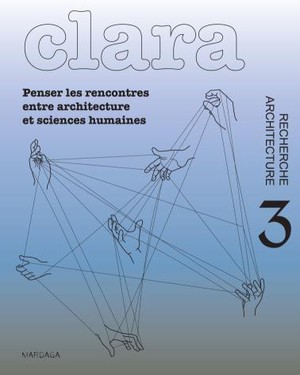A human and social dimension for residential architecture: the legitimising stories of two developers
Main Article Content
Abstract
Since the 2000s, when the context for residential development in France has changed, property developers have had to respond to the social issues raised by their new public partners. A meeting in 1998 with the chairman of George V Habitat and his architect, followed by a second in 2012 with a Bouygues Immobilier project manager, enabled us to analyse their interest in the human and social sciences. When dealing with researchers, institutional players or elected representatives, developers argue for their architecture using references borrowed from these disciplines, which marketing has led them to frequent. Denied by architectural critics, the 'soft architecture' that is the style of George V Habitat is explained by its symbolic significance, evoking concepts developed by Edgar Morin. A key feature of the competition in which Bouygues Immobilier is taking part, the contemporary architecture designed by renowned architects seeks to distinguish itself through a social dimension that a sociologist recruited for this purpose gives it. In the stories told by these developers, the human and social sciences provide legitimacy to the architecture they produce, but also to these commercial agents, who hope in this way to enhance their image with potential public partners.
Article Details

This work is licensed under a Creative Commons Attribution-NonCommercial-NoDerivatives 4.0 International License.
References
BAUDRILLARD, J. 1970. La société de consommation, Paris, Denoël.
BIAU,V. 1998. « Stratégies de positionnement et trajectoires d’architectes », Sociétés contemporaines, n° 29, p. 7-25.
BOURDIEU, P. 1979. La distinction, Paris, Éditions de Minuit.
BOUYGUES IMMOBILIER. 2012. Note d’intention, Nantes.
BOUYGUES IMMOBILIER. 2014. Site officiel. Consultable : http://www.bouygues-immobilier. com/bouygues-immobilier-et-vous/ nos-engagements/faire-de-votre- logement-une-source-de-bien-etre [disponible le 20 mars 2014].
CARU, A. ; COVA, B. 2006. « Expériences de consommation et marketing expérientiel », Revue française de gestion, n° 162, p. 99-113.
CATHELAT, B. 1990. Socio-styles système. « Les styles de vie ». Théorie, Méthodes, Applications, coll. CCA, Paris, éd. d’Organisation.
CENTRE DE COMMUNICATION AVANCÉE. 2010. « Prospective de vie des Français. Sept familles », Habitat et société, n° 57, p. 34-37.
DEBARRE, A. 1998. Professionnels de la conception : les promoteurs privés. Analyse des pratiques et de leur rapport à la qualité architecturale et à l’innovation, rapport de recherche pour le Plan urbanisme construction architecture, programme Qualité architecturale et innovation, ACS, École d’architecture Paris-Villemin.
DEBARRE, A. 1999. « Un regard paradoxal sur la promotion privée », Qualité architecturale et innovation. II. Études de cas, Plan urbanisme construction architecture, p. 71-85.
ELEB, M. ; NIVET, S. ; VIOLEAU, J.-L. 2005. L’Architecture entre goût et opinion. Construction d’un parcours et construction d’un jugement, rapport de recherche pour la Mission du Patrimoine ethnologique, ministère de la Culture.
GEORGAKAKIS, D. 1997. « Une science en décalage ? Genèses et usages des “socio-styles” du Centre de communication avancée (1972-1990) », Genèses, n° 29, p. 51-74.
HAMONIC, G. 2013. « Portrait I Hamonic + Masson : à eux deux ils pouvaient s’en sortir », Le courrier de l’architecte. Consultable : http:// www.lecourrierdelarchitecte.com/ article_4046 [disponible le 22 mars 2014].
HERPIN, N. 1986. « Socio-style », Revue française de sociologie, n° 27-2, p. 265-272.
JOBBÉ-DUVAL, H. 1998. Entretien avec l’auteur.
JOBBÉ-DUVAL, H. 1998a. Intervention au séminaire « Maîtres d’ouvrage », Plan construction et architecture, Paris.
JOBBÉ-DUVAL, H. 2003. « Quand Apollonia invente... LesVillas Suspendues®, propos recueillis de Hervé Jobbé-Duval d’Apollonia », d’A, n° 126, p. 24-26.
JUAN, S. 1994. « Les niveaux d’analyse sociologique des systèmes de représentation et de pratiques », Espaces et sociétés, n° 73, p. 13-30.
JULIEN, J.-J. 1998. Entretien avec l’auteur.
LÉGER, J.-M. 1990. Derniers domiciles connus. Enquête sur les nouveaux logements 1970-1990, Paris, Créaphis.
LUCAN, J. 2001. « Architectures fin de siècle », AMC, n° 112, p. 186-189.
MOINGEON, B. 1993. « La sociologie de Pierre Bourdieu et son apport au marketing », Recherche et applications en marketing, n° 8-2, p. 105-123.
MORIN, E. (1977) 1981. La Méthode. Tome 1 : La Nature de la Nature, coll. Points, Paris, Seuil.
MORIN, E. 1982. Science avec conscience, Paris, Fayard.
NANTES HABITAT, ENTREPART, 2011.Guide de la maîtrise d’usage, Nantes.
NIVET, S. 2003. « Travailler avec Apollonia, les expériences des architectes Sophie Denissof, Roland Castro etYves Lion », d’A, n° 126, p. 26.
NIVET, S. 2006. Architecture d’auteur vs produit commercial ? L’immeuble-villas et les Villas suspendues® : deux stratégies de communication, thèse de doctorat en architecture, sous la direction de M. Eleb, Université de Paris VIII.
NIVET, S. 2007. « Architectes/promoteurs : nouvelles affinités, nouveaux logements ? », d’A, n° 167, p. 59-74.
SPOERRY, F. 1991. L’architecture douce de Port-Grimaud à Port-Liberté, Paris, Robert Laffont.
VALETTE-FLORENCE, P. 1994. Les styles de vie. Bilan critique et perspectives. Du mythe à la réalité, Paris, Nathan.
VENTURI, R. (1966) 1976. De l’ambiguïté en architecture, Paris, Dunod.

